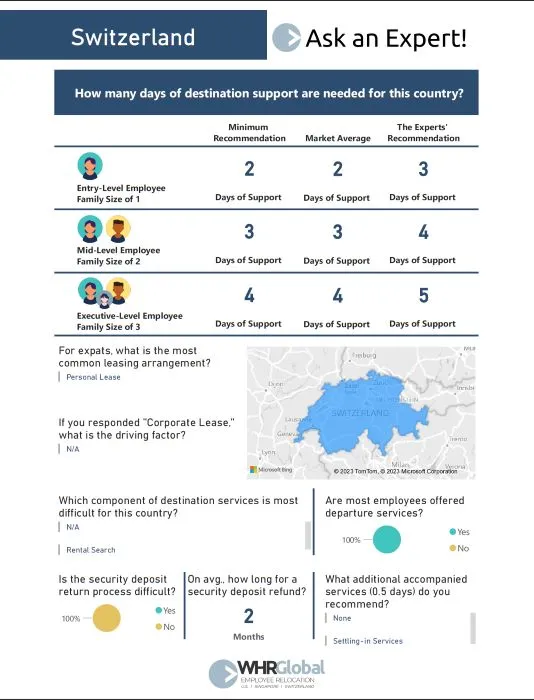
Hat Ihr Unternehmen die Akteure für globale Mobilität und Talentakquise strategisch aufeinander abgestimmt? Oder fühlen sich Ihre Teams mit unterschiedlichen Prioritäten und Auffassungen isoliert? Im Folgenden finden Sie 6 Möglichkeiten, wie Sie die Teams für globale Mobilität und Talentakquise aufeinander abstimmen können. Dazu gibt es Einblicke von Reda Belabed, GMS, einem Leiter für globale Mobilität und Einwanderung, der zuvor bei Honeywell und General Electric tätig war, und Sean Thrun, Strategic Initiatives Manager bei WHR Global.
Sie sind nicht allein, wenn Sie das Gefühl haben, dass Ihre Teams für globale Mobilität und Talentakquise nicht auf dieselben Ziele hinarbeiten! Glücklicherweise gibt es einige sinnvolle Maßnahmen, die Sie ergreifen können, um Ihre Talentmobilität zu verbessern und sicherzustellen, dass diese Akteure als ein zusammenhängendes Team arbeiten.
Wenn die Teams für globale Mobilität und Talentakquise aufeinander abgestimmt sind, werden Ihre hochspezialisierten Mitarbeiter schnell und vorschriftsmäßig eingestellt.
1. Verteilen Sie "How To" Relocation Guides an Ihre Global Mobility und Talent Acquisition Teams für die Hauptstandorte
Verteilen Sie "How To"-Leitfäden an Ihre Teams für Talentakquisition und globale Mobilität. Dabei sollte es sich um geschäftskritische Dinge handeln, die sie für die Hauptstandorte Ihres Unternehmens wissen müssen, einschließlich Einwanderung, Steuern und empfohlener Umzugsunterstützung. Zum Beispiel:
-
-
- Ihr Unternehmen stellt regelmäßig Führungskräfte ein, die in Ihrem niederländischen Global Center of Excellence arbeiten. Beantragen Ihre Teams die 30%-Regelung für die Niederlande? Ist Ihr Talentakquisitionsteam dafür verantwortlich, dass jeder Bewerber die Anforderungen der 30 %-Regelung erfüllt, bevor er das Stellenangebot unterbreitet? So muss Ihr Talentakquisiteur beispielsweise sicherstellen, dass der Bewerber über spezifische Fachkenntnisse verfügt, mehr als 150 km von der niederländischen Grenze entfernt rekrutiert wird und vieles mehr.
- Aufgrund des hochspezialisierten Charakters Ihres Unternehmens rekrutieren Sie interne und externe Kandidaten für eine Stelle in den USA. Ist Ihr Talentakquisitionsteam mit den verschiedenen Visumstypen in den USA vertraut, z. B. dem L-1-Visum für unternehmensinterne Versetzungen oder dem H-1B-Visum für spezielle Berufe? Ihre Talentakquisitionsteams sollten die grundlegenden Anforderungen für jede Visumart kennen, bevor sie versuchen, ausländische Talente zu finden.
- Ihr RMC sollte proaktiv den Umfang der benötigten Umzugsunterstützung nach Land für Ihre Hauptstandorte festlegen. Der 2023 Destination Services Benchmark Report zeigt zum Beispiel das minimale, durchschnittliche und empfohlene Niveau der Zielortunterstützung nach Land, Familiengröße und Mitarbeiterebene. Der Bericht gibt auch an, ob es sich bei den Mietverträgen um Privat- oder Firmenmietverträge handeln sollte, wie lange es dauert, bis man die Kaution zurückerhält, und welche Komponenten die größten Herausforderungen darstellen.
-
2. Überprüfung von Metriken zur Talentakquise wie Time-To-Fill
Leider wird die Talentakquise nicht nur am Volumen/an der Qualität der besetzten Stellen gemessen, sondern vor allem an der Zeit bis zur Besetzung, was oft zu einer kritischen Diskrepanz zwischen den Bedürfnissen des Unternehmens, der Erfahrung der Kandidaten und der harten Realität der Einhaltung der Vorschriften führt.
Ich habe ein funktionsübergreifendes Verfahren zur Vorabbewertung der so genannten "Immigration Hire-ability" eingeführt, sofern dies gesetzlich zulässig ist. Dort, wo es angewandt wurde, bin ich recht zufrieden mit dem Grad der Partnerschaft zwischen den beiden Funktionen (und letztlich mit der Minderung des Risikos von "Fehlbesetzungen"). An anderen Stellen schienen Datenschutzbestimmungen und faire Beschäftigungspraktiken Hürden für die Umsetzung zu sein. Es gibt nicht viel Flexibilität, wenn es um Arbeit und Beschäftigung geht, durch Betriebsräte und dergleichen, und das war wirklich eine Herausforderung.
Eines der Pflaster, auf das wir uns in diesen Fällen konzentriert haben, sind verstärkte (und wiederholte) Schulungs- und Aufklärungssitzungen mit den Personalvermittlern, um sie auf den neuesten Stand zu bringen, worauf sie achten müssen bzw. wie sie "rote Fahnen" erkennen können, und um die gesamte Kommunikationsstrategie (bis zur Angebotsannahme) zu überprüfen, damit alle Beteiligten ein besseres Verständnis für die potenziellen Risiken haben, die mit der Einstellung von Kandidaten mit Migrationsstatus und/oder Sponsoring-Anforderungen und -Verantwortlichkeiten verbunden sind (einschließlich Kosten, Fristen, Einwanderungslebenszyklen sowie Talentmanagementstrategien).
Ich denke, wir machen alle Fortschritte, aber es ist noch ein weiter Weg, bis wir sagen können, dass wir mit dem Niveau der Zusammenarbeit und der Partnerschaft zufrieden sind, mit einer 100-prozentigen Zufriedenheit der Bewerber, einer verbesserten TTF-Kennzahl und einer zufriedenstellenden Bewertung der Einhaltung der Einwanderungsbestimmungen vor der Einstellung.
3. Einführung von Vorabkontrollen zur Erhöhung der Erfolgsquote
Wie bereits angedeutet, können Mobilitätsprogramme die Annahme von Aufträgen und die Erfolgsquote erheblich steigern, indem sie verschiedene Kontrollpunkte vor der Annahme einrichten.
-
-
- Beauftragen Sie eine angesehene Steuerberatungsfirma. Sie können nicht nur Länderbriefings für die Mitarbeiter durchführen, sondern auch den Talentakquisitionsteams wertvolle Hinweise geben. Stellen Sie zumindest sicher, dass Ihre Talentakquisitionsteams mit den Konzepten der Steuerassistenz, des Steuerausgleichs und der Totalisierungsvereinbarungen vertraut sind . Bieten Sie allen ausländischen Bewerbern vor der Aufnahme eine Steuerberatung an.
- Bei länderspezifischen Steuergesprächen sollten sich die Bewerber über ihre Möglichkeiten im Klaren sein, bevor sie die Stelle annehmen, da etwaige Missverständnisse das Risiko einer gescheiterten Versetzung oder Entsendung erheblich erhöhen können. Zugewiesene Mitarbeiter (vor allem in leitenden Positionen) können komplizierte Anlageportfolios mit Aktien, Aktienoptionen, Anleihen, Immobilienbesitz, Edelmetallen wie Gold usw. haben. Je nach Standort, Staatsangehörigkeit(en) und Art der Versetzung (dauerhafte Versetzung, langfristige Versetzung, kurzfristige Versetzung, Pendler, Geschäftsreisende) haben die Mitarbeiter sehr unterschiedliche Möglichkeiten.
- Wie bereits in Schritt 2 erwähnt, sollten Sie Ihr eigenes funktionsübergreifendes Vorprüfungsverfahren (auch bekannt als Leitfaden für die Einstellungsfähigkeit bei der Einwanderung) entwickeln, sofern dies gesetzlich zulässig ist. Dabei sollten Sie jedoch die schwierigen Rechtssysteme wie die Vereinigten Staaten und die Europäische Union berücksichtigen, wie Reda Belabed weiter ausführt:
-
Länder wie die USA, in denen sich die Fragen auf die Frage beschränken können, ob Sie oder in Zukunft einen Sponsor benötigen, und andere EU-Länder, in denen die Abfrage persönlicher Informationen/Daten als personenbezogene Daten betrachtet werden kann und ein Hindernis für faire Beschäftigungspraktiken/Diskriminierung bei der Einstellung darstellt. Geografische Regionen wie der Nahe Osten (insbesondere der GCC) sind offener für diese Bewertungen.
Behörden, die schon seit langem ausländische und vielfältige Arbeitskräfte beschäftigen, neigen dazu, den Rückgriff auf Prüfungen der Einstellungsfähigkeit auf der Grundlage der Anforderungen an die Staatsangehörigkeit zuzulassen bzw. zu fördern, setzen sich aber auch für mehr Transparenz in Bezug auf "Quoten" ein. Nicht, dass Nationalitätsquoten etwas wären, was man gutheißen sollte, aber die Transparenz hilft, die Machbarkeit im Voraus zu bestimmen - anstatt mit den Bewerbern in der Angebotsphase zu verhandeln, nur um dann festzustellen, dass es vielleicht nicht möglich ist. Aus organisatorischer Sicht ist das Verfahren recht transparent und schlank.
4. Vorentscheidungsgespräche durch Ihre Relocation Management Company (RMC)
Ihr globales Mobilitätsteam und Ihr RMC können sich auch für die Durchführung von Vorabentscheidungsgesprächen entscheiden. Im Rahmen des Relocation Managements stellen Gespräche vor der Entscheidung sicher, dass der Kandidat das Relocation-Paket versteht, das er erhalten wird. Sie sind aber auch eine Gelegenheit für Ihren RMC, Ihr Unternehmen und Ihr Leistungspaket zu bewerben und etwaige Bedenken des Mitarbeiters oder seiner Familie zu zerstreuen.
Vorentscheidungsgespräche verhindern auch Unstimmigkeiten oder Missverständnisse, wenn der Mitarbeiter das Angebot annimmt und der Umzugsprozess beginnt. Nach dem Telefonat im Vorfeld der Entscheidung weiß der Mitarbeiter beispielsweise genau, welches Paket er erhalten wird, wie hoch die einzelnen Umzugszuschüsse sein werden und vieles mehr. Oftmals gibt es eine Diskrepanz zwischen dem von einem Talentakquisiteur oder HR-Geschäftspartner angebotenen Umzugspaket und dem vom RMC umgesetzten Umzugspaket. Dies kann auf menschliches Versagen zurückzuführen sein oder darauf, dass jemand mit einer alten/überholten Richtlinie arbeitet. Diese Diskrepanzen können minimiert werden, wenn der RMC das Relocation-Paket vor der Entscheidung erläutert und das Relocation-Paket nach der Zusage umsetzt.

5. Optimieren Sie Ihr HRIS für maximale Talentmobilität
Ihr Unternehmen kann die Mobilität von Talenten maximieren, indem es benutzerdefinierte Felder, Objekte und Berichte in Ihrem HRIS (Human Resources Information System) erstellt. In ADP kann Ihr Unternehmen zum Beispiel einen Talentpool von Bewerbern erstellen und verwalten, die bereit sind, für offene Stellen umzuziehen. Ihr Unternehmen sollte aber auch bestehende Mitarbeiter nicht übersehen, die bereit sind, für einen unternehmensinternen Wechsel umzuziehen. Bestehende Mitarbeiter sollten Ihre Produkte, Dienstleistungen und Erwartungen kennen, was die Kosten für Einstellungen und Schulungen reduziert.
Laut SHRM-Benchmarking liegen die durchschnittlichen Kosten für die Einstellung einer Führungskraft bei 28.329 USD. Viele Arbeitgeber schätzen jedoch, dass die Gesamtkosten für die Einstellung eines neuen Mitarbeiters das Drei- bis Vierfache des Gehalts für die Stelle betragen können. Dabei handelt es sich um eine Kombination aus harten Kosten, z. B. für Personalvermittler, und weichen Kosten, z. B. die Zeit, die Abteilungsleiter und Manager benötigen, um den Einstellungs- und Schulungsprozess zu unterstützen.
Anstatt neue Bewerber von Grund auf zu suchen, sprechen Sie mit Ihrer IT-Abteilung über das Hinzufügen von benutzerdefinierten Feldern, Objekten und Berichten zu Ihrem HRIS-System. Dann können bestehende Mitarbeiter in ihrem HR-Profil angeben, ob sie bereit sind, für eine neue Stelle umzuziehen. Innerhalb der benutzerdefinierten Berichte können Sie auch Filter hinzufügen, um Ihren Talentpool auf leistungsstarke Mitarbeiter einzugrenzen, die bereit sind, umzuziehen, und zwar in Kombination mit früheren Leistungsbewertungen, die bereits in das HRIS geladen sind.

6. Regelmäßige Schulungen mit den Teams für die Talentakquise durchführen
Regelmäßige Schulungen stellen sicher, dass Ihre Talentakquisitionsteams Zugang zu denselben Systemen, Ressourcen und Antworten auf Fragen haben, die von Bewerbern vor und nach der Einstellung häufig gestellt werden. Schulungen bieten auch neuen Mitgliedern des Talentakquiseteams die Möglichkeit, mehr über die Mobilitätspakete zu erfahren, die Ihre Mitarbeiter erhalten, und verstärken die Botschaft, dass alle Talentakquiseteams die gleichen standardisierten Prozesse befolgen sollten.
Um die Mobilität von Talenten zu verbessern, veranstalten Relocation-Management-Unternehmen regelmäßig Schulungen mit Talent-Akquisitions-Teams und relevanten Interessengruppen. Diese Schulungen können Folgendes umfassen:
-
-
- Vor-Ort-Schulungen durch die Relocation Management Company für Mobilitäts-, TA- und HR-Teams. Je nach Größe Ihres Mobilitätsprogramms kann Ihr RMC diese Schulungen kostenlos durchführen oder Ihr Unternehmen bitten, die Hotel- und Reisekosten zu übernehmen (je nach Entfernung und Dauer).
- Virtuelle Schulungen im Webinar-Stil durch das RMC.
- Länder- oder regionalspezifische Schulungen für die wichtigsten Standorte Ihres Unternehmens oder für Standorte mit besonderen Schwierigkeiten.
- Einblicke von Destination Service Providern (DSPs) und Vermietungsagenturen in Bezug auf Marktaktualisierungen, kulturelle Normen und bewährte Verfahren.
- Ratschläge von Einwanderungsfirmen zu roten Fahnen, Quoten, geschätzten Fristen, Mindestgehältern, Anforderungen an Arbeitsmarkttests und mehr.
-
Wir haben bei der Umstellung regionaler Strukturen auf ein zentralisiertes globales Mobilitätsprogramm erhebliche Erfolge erzielt, indem wir regelmäßige Schulungen für die Führungskräfte der Talentakquise durchgeführt haben. In diesen Sitzungen geht es in erster Linie um Reisepläne und wichtige Überlegungen während des gesamten Prozesses. Durch die aktive Einbeziehung regionaler TA-Stakeholder in Diskussionen über die Vorteile der Mobilität und die gewünschten Ergebnisse haben wir eine spürbare Zunahme ihrer Bereitschaft zur Übernahme standardisierter Prozesse beobachtet.
Zusammenfassend lässt sich sagen, dass die Abstimmung zwischen den Teams für globale Mobilität und Talentakquise für Unternehmen von entscheidender Bedeutung ist, um eine effiziente Einstellung und erfolgreiche Talentmobilität zu gewährleisten. Durch die Verteilung von Relocation Guides, die Überprüfung von Talentakquisitionsmetriken, die Implementierung von Checkpoints vor der Annahme, die Durchführung von Pre-Decision Calls, die Optimierung von HRIS-Systemen und die Durchführung regelmäßiger Schulungen können Unternehmen die Zusammenarbeit fördern und die Effektivität dieser Teams verbessern. Die Angleichung führt zu einer zügigen und gesetzeskonformen Einstellung von Fachkräften, reduziert Risiken, verbessert die Time-to-Fill-Kennzahlen und steigert letztlich die allgemeine Zufriedenheit der Bewerber und die Einhaltung der Einwanderungsbestimmungen. Kontinuierliche Bemühungen und Investitionen in die Abstimmung dieser Teams werden zu einem effizienteren und erfolgreicheren Talentakquisitionsprozess beitragen.

